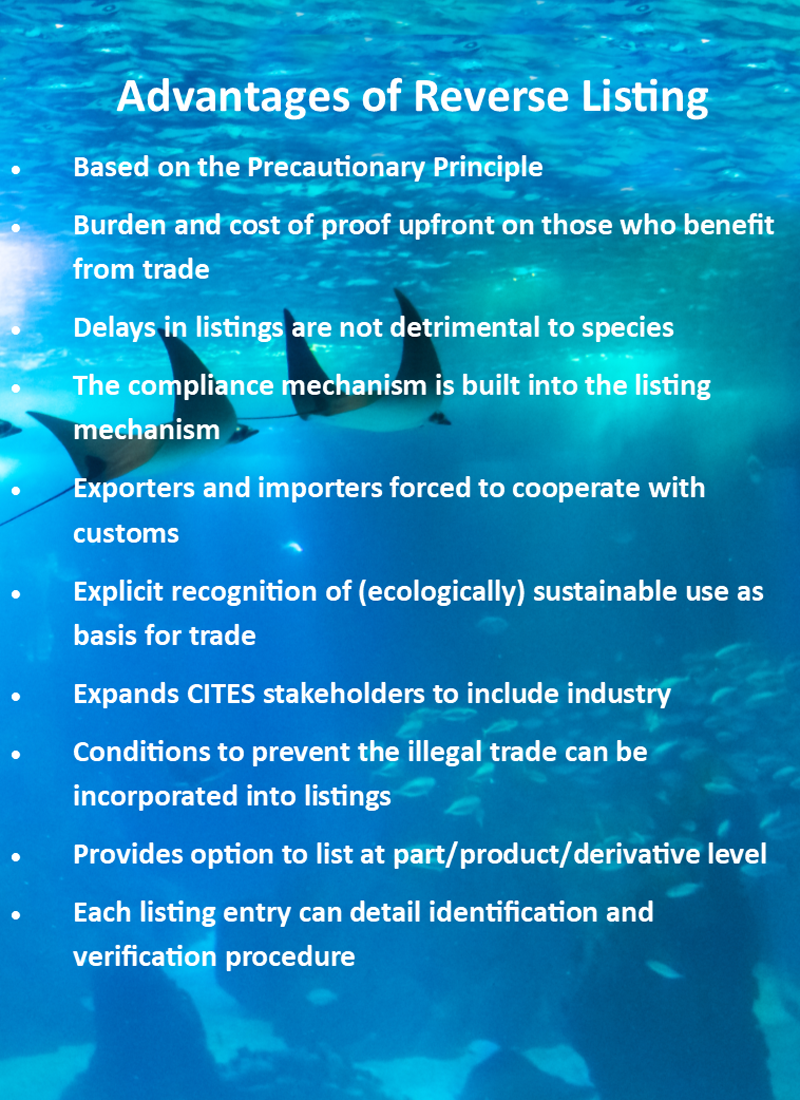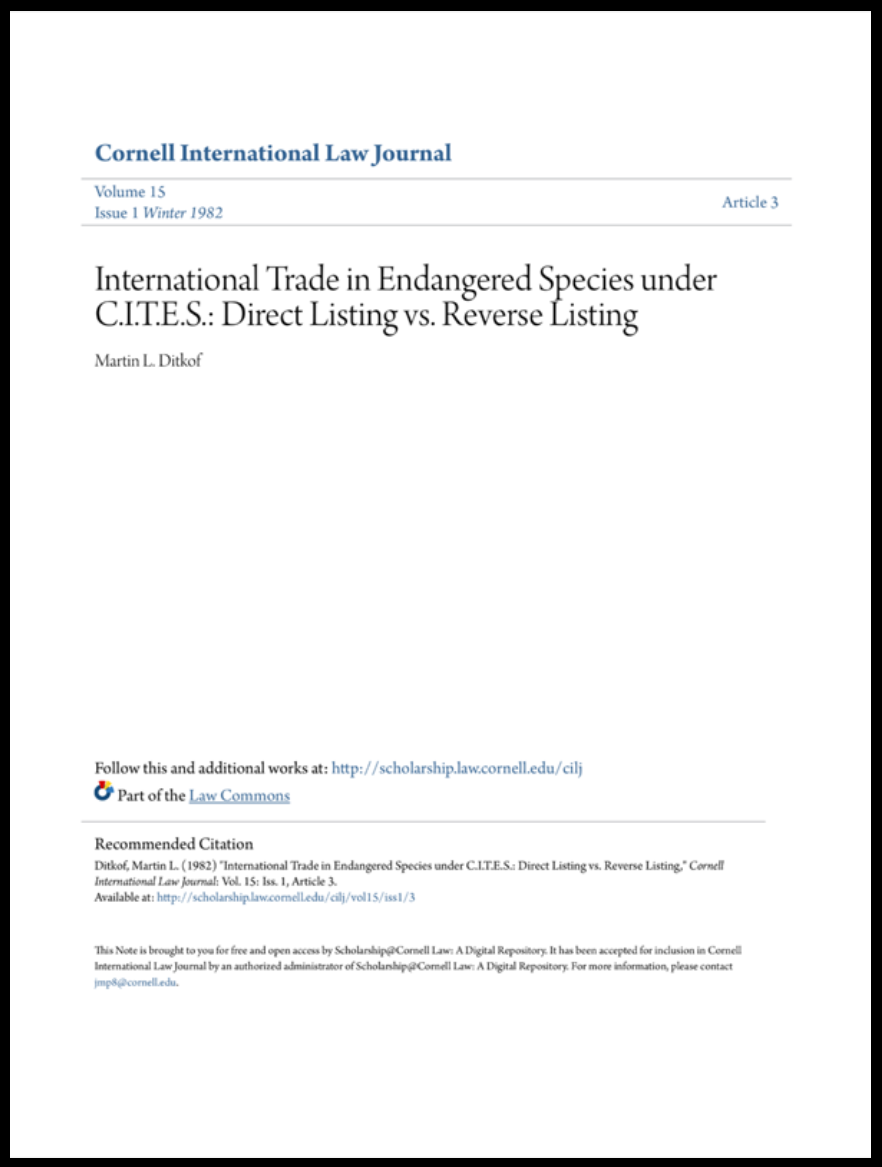Reverse Listing Summary
CITES uses a black-listing model – making unrestricted trade the default and listing species seen as endangered through trade for restrictions via the appendices. This so-called ‘direct’ listing model puts the burden of proof for the (lack of) sustainability of trade in a species or population onto national governments, philanthropists and NGOs. The businesses that profit from the trade are exempt from contributing to the regulatory and enforcement costs, beyond paying a token amount for their CITES permits.
That this model is no longer working with over 40,000 species already listed and no significant additional funds having been made available for monitoring, enforcement or even research should be self-evident when looking at the massive scale of the illegal trade and the lack of sustainability of the legal trade. A perfect example of it no longer working was highlighted in a paper published in February 2019, which found that species identified by the IUCN Red List as being threatened from trade:
- Can wait as long as 19 years for protection under CITES, or
- Have already been waiting up to 24 years to be listed after first being named.
Because unrestricted trade is the default under CITES, IUCN Red Listed species can be traded freely until they get listed on the CITES Appendices. The authors finished by urging policymakers to hasten the wildlife protection process.
This perfectly summarises why the current blacklisting model hasn’t worked. We believe that given the scale of the trade and the rapid decline in wildlife populations, making unrestricted trade the default position is no longer viable. A white-listing system, (also known as positive or reverse listing) where the default is ‘no trade’, would appear a common sense approach given the May 2019 IPBES Report where the trade in flora and fauna was confirmed as the second biggest threat to species survival. The report also states that up to 1 million species are potentially facing extinction.
Based on the precautionary principle, given the level of biodiversity decline and the magnitude of the trade in wild species, the default position has to be ‘no trade’. This would require changing the articles of the convention to a ‘reverse listing’ (or positive listing) model. Under such a postive listing model the burden of proof that trade is compatible with ecologically sustainable use would be on those wishing to trade. A reverse listing mechanism would also allow the inclusion of identification, traceability and verification requirements into individual listings, thereby closing some of the current loopholes used by the illegal trade.
Trade would only be allowed once the assessment process has demonstrated that trade at the level proposed would be ecologically sustainable and ongoing real-time monitoring of trade would have to become the norm to make sure all trade is legal and traceable. This is the only viable way to achive the CBD post-2020 global biodiversity framework Target 5 – to make all trade legal and sustainable.
Note: This does not mean that industry will dictate the framework and criteria for what constitutes ‘ecologically sustainable use’ and what can be traded. We have outlined a detailed model for keeping industry at arms-length in our Modernising CITES report. Our model also incorporates a secure funding mechanism to make reverse listing viable, with all regulatory costs falling on the businesses that profit the most.
Why Reverse Listing?
When CITES was set up in 1973, it adopted a black-listing (or ‘direct listing’) model – making unrestricted trade the default. At the time the wildlife trade was assumed to be worth around US$5 billion annually and some 9,000 species of flora and fauna were assumed to be traded.
Even if these assumptions were correct in the 1970s, none of them are valid today. Both the legal and illegal trade in flora and fauna have grown massively, to US$320 billion annually and as much as US$258 billion annually, respectively. Today CITES lists over 40,000 species for trade restrictions on Appendix, I, II and III and it is unknown how many species are being actively traded.
The direct listing model:
- Assumes that the lack of knowledge about a species, its populations and use in trade should not be seen as an impediment to trade.
- Presumes that the default behaviour of all actors in the wildlife trade is not a threat to sustainability.
- Puts the burden of proof for the (lack of) sustainability of trade in a species or population onto national governments, academics and NGOs.
- Relies on the ability of customs to manage identification of species and verification of shipments.
- Exempts the businesses that profit from the trade from contributing to the regulatory and enforcement costs, beyond paying a token amount for their CITES permits.
The first point may seem ‘esoteric’, but the reality is that we have reliable population data for only a very small number of (high-profile) species. Most fish populations are simply estimated from their catch levels, which inevitably produces overestimates of their size (fishing boats only fish where the fish are, so extrapoating from those areas will not produce valid population data). We know precisely nothing about the population sizes of the most traded mammal on the planet, the 8 species of pangolin.
The second point in inherent to all blacklisting models. Blacklisting is used to criminalise behaviours that fall outside of accepted social norms – hence all criminal law uses blacklisting to outlaw murder, manslaughter, assault and so on. It presumes that the vast majority of actors will NOT engage in these behaviours. This is clearly not the case for the wildlife trade, the default behaviour of any company under capitalism is to grow profits and externalise costs. This means overexploitation and destruction are inherent to the business model.
We believe that given the scale of the trade today and the rapid decline in wildlife populations, making unrestricted trade the default position is no longer viable. Based on the precautionary principle, the default position today has to be ‘no trade’. This would require changing the articles of the convention to a ‘reverse listing’ or white-listing model.
Under a reverse listing model:
- The burden of proof that trade is compatible with ecologically sustainable use (e.g. using the Addis Ababa principles) would be on those wishing to trade, that is the businesses using wild species in their products.
- The listing criteria (for allowing trade) would incorporate demand-side considerations, effects of the illegal trade, effects on enforcement and other criteria already used within CITES rather than simply focusing on supply-side factors.
- The CITES authorities would set the standards, but businesses would be required to pay for the necessary research. This is the same in other industries that use a white-listing approach, such as pharmaceuticals, medical implants, aircraft components and pesticides (although it will be mainly importers that pay in the CITES case, not producers).
A reverse listing mechanism would also allow to include identification, traceability and verification requirements into individual listings, thereby closing some of the current loopholes used by the illegal trade.
Nature Needs More is actively working with CITES signatory countries and NGOs to promote the reverse listing model. In the first instance, we have published a comprehensive new regulatry framework in our Modernising CITES Report.

More examples of the legal trade, while a growing number of designers are rejecting python and crocodile skin, stingray is increasingly used for accessories even though report from the IUCN suggests that a quarter are actually threatened with extinction.
It is important to recall that most industry regulation is done via white-listing, i.e. by regulating ‘what is allowed’ and not what is forbidden. Probably the best known examples are pharmaceuticals and aircraft, but it applies to some degree to most consumer products (think of the CE mark, or FCC approval for communication devices, design rules for cars etc.). White-listing means the compliance mechanism is built into the ‘listing mechanism’ – if you don’t comply with the regulations you cannot list a drug for sale or fly an aircraft. In short ‘if you don’t comply you cannot trade‘.
- Pharmaceuticals are regulated by the FDA in the US and the EMA (plus national bodies) in the EU. Industry pays for and carries out the necessary research to submit an application for approval to the regulator. Industry further pays fees to the regulator to have applications reviewed. Drugs are only approved for sale (read: trade) once the regulator is satisfied that they are safe to use and efficacy has been proven. The burden of proof is on industry based on a process designed by the regulator.
- Aircraft (and their components) are regulated by the FAA in the US and EASA (plus national bodies) in the EU. Industry has to register with the regulator for design approvals and type certification. All burden of proof is on industry, based on standards designed and maintained by the regulator. Again, aircraft are only certified once the regulator is satisfied that they are safe to use and compliant with standards.
The History Of The Reverse Listing Idea
1981 Reverse Listing Proposal
 In 1981 Australia submitted a proposal to study the reverse listing model to the 3rd CITES Conference of the Parties in New Delhi. The proposal highlighted the concern that for too many species there wasn’t a ‘sufficient level of knowledge, management and control to ensure that the proposed trade will not threaten the species survival’. This same situation persists today, only on a much larger scale. For example, for the pangolin, considered the most traded mammal on the planet, we still have next to no knowledge about population sizes, trade volumes and absolutely no management or control.
In 1981 Australia submitted a proposal to study the reverse listing model to the 3rd CITES Conference of the Parties in New Delhi. The proposal highlighted the concern that for too many species there wasn’t a ‘sufficient level of knowledge, management and control to ensure that the proposed trade will not threaten the species survival’. This same situation persists today, only on a much larger scale. For example, for the pangolin, considered the most traded mammal on the planet, we still have next to no knowledge about population sizes, trade volumes and absolutely no management or control.
In addition, the Australian proposal correctly recognised that the continuing addition of species to the appendices under the direct listing model would lead to immense practical difficulties in identification and enforcement at customs, especially given the fact that many species are very similar in appearance and not easy to distinguish.
Whilst Australia’s proposal was adopted, the subsequent study of the reverse listing model did not result in further action. This can be understood based on the Cornell paper from 1982 (see opposite). Looking solely from a 1982 perspective the problems Australia was foreseeing where simply not yet ‘big enough’ to warrant action.
1982 Reverse Listing Paper
 In 1982 Martin Ditkof published a paper assessing the Australian reverse listing proposal. His core argument in rejecting the ‘major adjustments’ that would be required to CITES procedures and national implementations was centered around the fact that a lot more species (he estimated 10,000) were being actively traded than being listed for trade restrictions (700 at the time). This to him meant an increase in complexity for no immediate benefit.
In 1982 Martin Ditkof published a paper assessing the Australian reverse listing proposal. His core argument in rejecting the ‘major adjustments’ that would be required to CITES procedures and national implementations was centered around the fact that a lot more species (he estimated 10,000) were being actively traded than being listed for trade restrictions (700 at the time). This to him meant an increase in complexity for no immediate benefit.
While Ditkof acknowledged that the reverse listing approach would shift the burden of proof that a shipment is legal from customs to the exporter/importer, he asserted that implementing the reverse listing system would not be practical because it would involve listing over 9,000 species. Today, CITES maintains that its black-listing model is still practical despite listing nearly 36,000 species!
His primary argument against adopting reverse listing was that changing the convention would not necessarily improve its effectiveness and would divert its limited resources of time and money away from its core objective of protecting species. He was talking about the time and money dedicated to monitoring 700 listed species and the effectiveness of protecting those 700. It should be immediately obvious that this argument works in reverse with over 40,000 listed species today.
2020 Statement Martin Ditkof
 You will imagine our surprise as we logged on to find an email from Marty Ditkof, author of the 1982 analysis of the reverse listing approach – the email read: “Guys: I completely agree with your analysis of my 1982 article on whether reverse listing made sense. The times have changed.” We invited Marty to write a statement, for our Reverse Listing page, about his change in thinking and we were delighted he agreed; the statement is published in full. Thanks Marty. We hope that Marty’s story will trigger a more open minded response to the reverse listing proposal.
You will imagine our surprise as we logged on to find an email from Marty Ditkof, author of the 1982 analysis of the reverse listing approach – the email read: “Guys: I completely agree with your analysis of my 1982 article on whether reverse listing made sense. The times have changed.” We invited Marty to write a statement, for our Reverse Listing page, about his change in thinking and we were delighted he agreed; the statement is published in full. Thanks Marty. We hope that Marty’s story will trigger a more open minded response to the reverse listing proposal.

Hypothetical – If pharmaceutical trade was regulated like the wildlife trade.
Hypothetical – If pharmaceutical trade was regulated like the wildlife trade.

In 2018, European Medicines Agency had an Annual budget of
€317 Million (US$350 Million)
90% from industry fees
The organisation has 900 staff who in 2018 processed 60(!) applications
Of the 60, 45 were denied
Compare this to the system that regulates the trade in wildlife and botanicals and it is obvious how the natural world is being neglected.
Imagine we live in a world that when a pharmaceutical company creates a new drug it doesn’t have to test it in the lab, it doesn’t need to do human trials and it doesn’t need regulatory approval; it is simply manufactured and then legally sold.
Once on the market the drug appears to have some terrible side effects and consequences. The groups concerned about the negative effects of this new drug on human lives must scrape together funding, from donors, to undertake research to show their concerns are valid. Each year data is collected from all regions of the world highlighting the negative side effects of the drug together with the number of direct and indirect deaths associated with the drug. This is done for each demographic who uses the drug, including: men, women, children and teens, senior citizens, pregnant women, people with a disability, people with mental health issues etc.
When these concerned parties present their findings about the negative effects of the drug, they are challenged to provide evidence upon evidence upon evidence to back up their concerns, yet the pharmaceutical company isn’t held to the same standards to provide evidence that the drug is safe.
Imagine further that the system that monitors the volume of trade and distribution of this drug (and all drugs) is a paper-based, doesn’t integrate with customs, has been reviewed once in 45 years (in 1994) and has been constantly shown to have flaws that you can drive a Mack Truck through.
On top of this, everyone gets together to review what has been happening in the trade only once every three years. Trends on the negative side-effects of the drug and the mortality rates are tabled. There are clear indications that the trade in this drug is not safe for humans, but the only result is that another 3 years of research is requested, before a decision may be made to stop selling the drug – the can is once again kicked down the road. Add to this, imagine there are 40,000 drugs listed for sale (40,000 endangered species are listed under CITES for trade restrictions) and the above needs to be done for every demographic and in every region of the world.
Would society let human lives be treated in this way? Would we give the pharmaceutical industry unrestricted ability to trade (or maybe have some minimal restrictions on trade) until, after decades of research demonstrating the drug is unsafe to the human population, researchers stand up and clap with relief (which is what happened when pangolins were listed on CITES Appendix 1) when, once-and-for-all, we finally get agreement to ban the trade in this drug?
Again, I ask the question, would we be willing to compromise people’s safety and survival in this way? No, of course we wouldn’t, because it would be a ridiculous approach, right? But we accept this very system for the trade in endangered species.
While the pharmaceutical industry has to apply the precautionary principle, paying for years of research up front (which is a reverse listing approach by the way), to show that a drug is safe for human consumption, in contrast, the default for the world’s endangered wildlife and plants is trade first until it is proven to have severe, negative consequences for the survival of the species.


